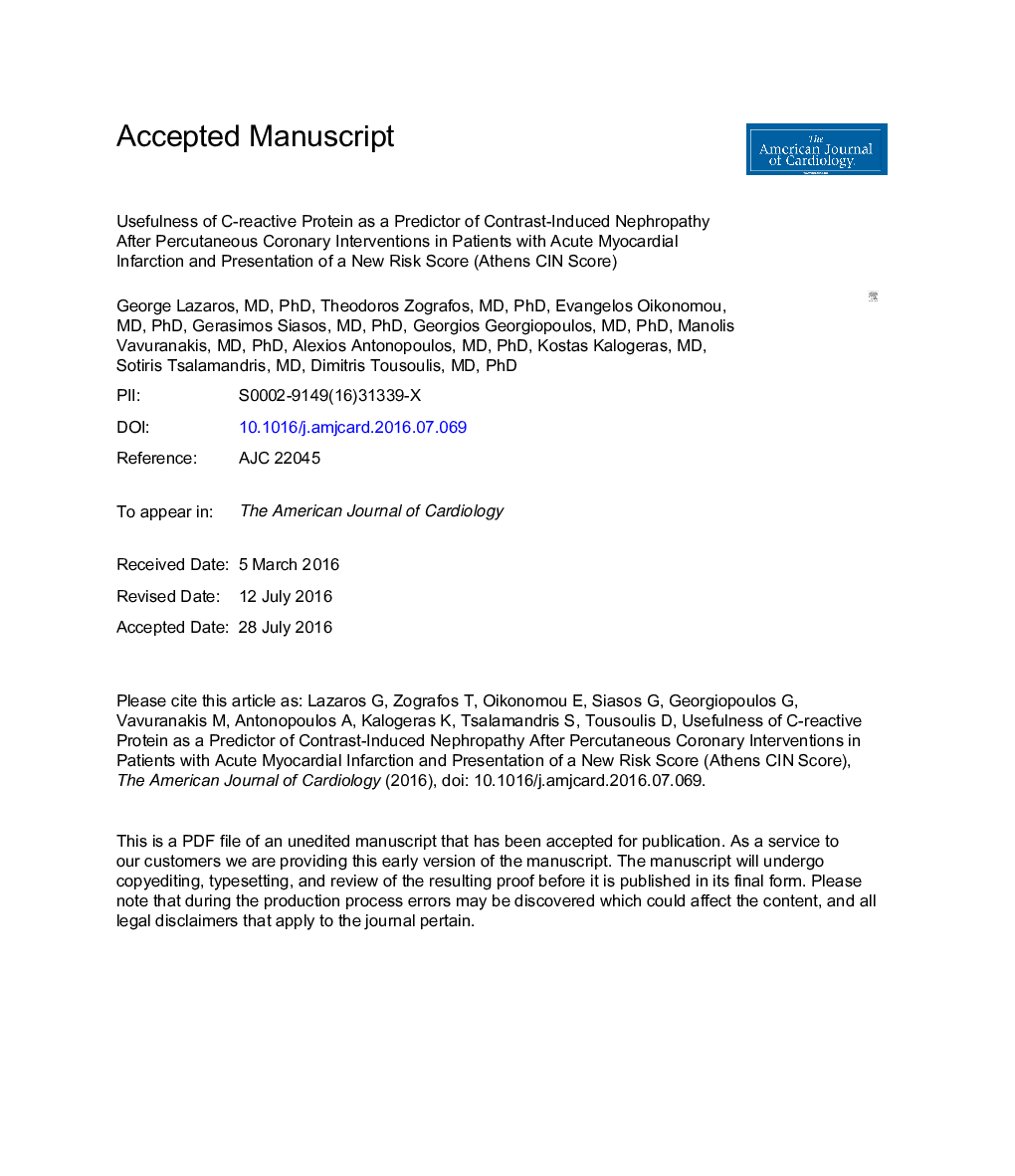| کد مقاله | کد نشریه | سال انتشار | مقاله انگلیسی | نسخه تمام متن |
|---|---|---|---|---|
| 5595333 | 1572101 | 2016 | 25 صفحه PDF | دانلود رایگان |
عنوان انگلیسی مقاله ISI
Usefulness of C-Reactive Protein as a Predictor of Contrast-Induced Nephropathy After Percutaneous Coronary Interventions in Patients With Acute Myocardial Infarction and Presentation of a New Risk Score (Athens CIN Score)
دانلود مقاله + سفارش ترجمه
دانلود مقاله ISI انگلیسی
رایگان برای ایرانیان
موضوعات مرتبط
علوم پزشکی و سلامت
پزشکی و دندانپزشکی
کاردیولوژی و پزشکی قلب و عروق
پیش نمایش صفحه اول مقاله

چکیده انگلیسی
Contrast-induced nephropathy (CIN) after percutaneous coronary interventions (PCI) in patients with acute myocardial infarction (AMI) is associated with high morbidity and mortality, whereas there are no reliable predictive tools easy to use. We evaluated the association of pre-procedural high-sensitivity C-reactive protein (hsCRP) with the development of CIN and integrated this variable in a new risk CIN prediction model. Consecutive patients (348 AMI subjects) who underwent PCI were recruited. Creatinine levels were detected on admission, at 24, 48, and 72 hours after PCI. CIN was defined using the Kidney Disease: Improving Global Outcomes criteria. In our study population (348 subjects), CIN developed in 54 patients (15.5%). Patients with CIN were older and had higher hsCRP at admission, whereas their ejection fraction (EF) and glomerular filtration rate (GFR) were lower. In multivariate analysis after incorporating potential confounders, hsCRP at admission was an independent predictor of CIN (OR for logCRP 2.00, p = 0.01). In receiver-operating characteristic curve analysis, a model incorporating hsCRP, age, GFR, and EF showed good accuracy in predicting the development of CIN (c statistic 0.84, 95% confidence interval 0.793 to 0.879). A total risk score derived from the proposed model yielded significant positive and negative predictive values and classified 85.8% of our patients correctly for CIN. In conclusion, measuring hsCRP levels at admission in patients who underwent PCI for AMI may offer additional assistance in predicting the development of CIN. A model incorporating age and admission hsCRP, EF, and GFR emerged as an accurate tool for predicting CIN in this context.
ناشر
Database: Elsevier - ScienceDirect (ساینس دایرکت)
Journal: The American Journal of Cardiology - Volume 118, Issue 9, 1 November 2016, Pages 1329-1333
Journal: The American Journal of Cardiology - Volume 118, Issue 9, 1 November 2016, Pages 1329-1333
نویسندگان
George MD, PhD, Theodoros MD, PhD, Evangelos MD, PhD, Gerasimos MD, PhD, Georgios MD, PhD, Manolis MD, PhD, Alexios MD, PhD, Kostas MD, Sotiris MD, Dimitris MD, PhD,